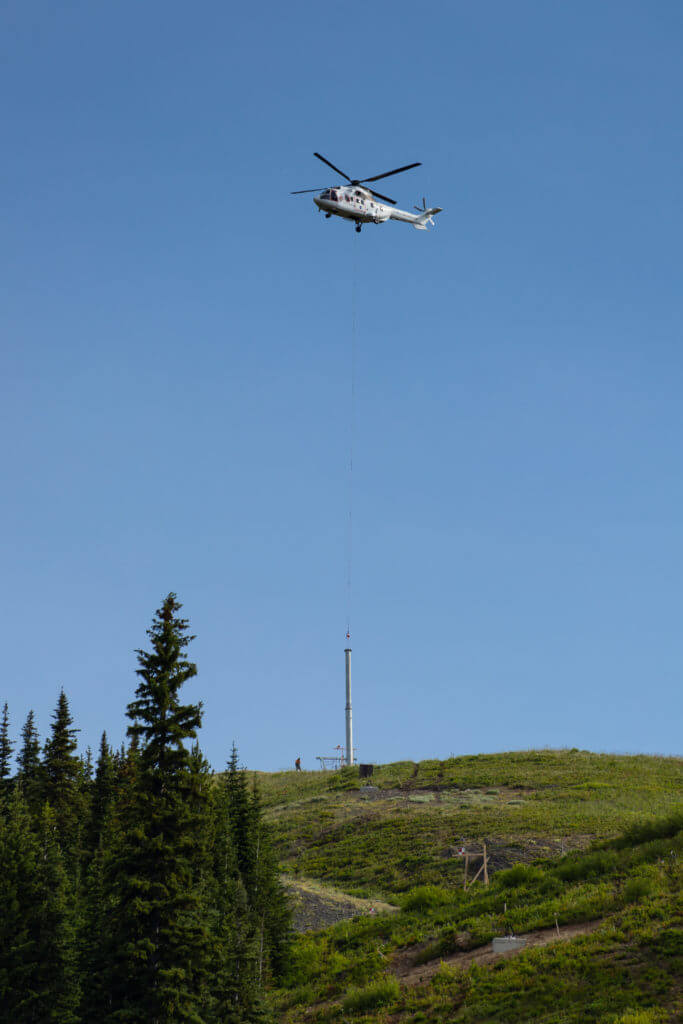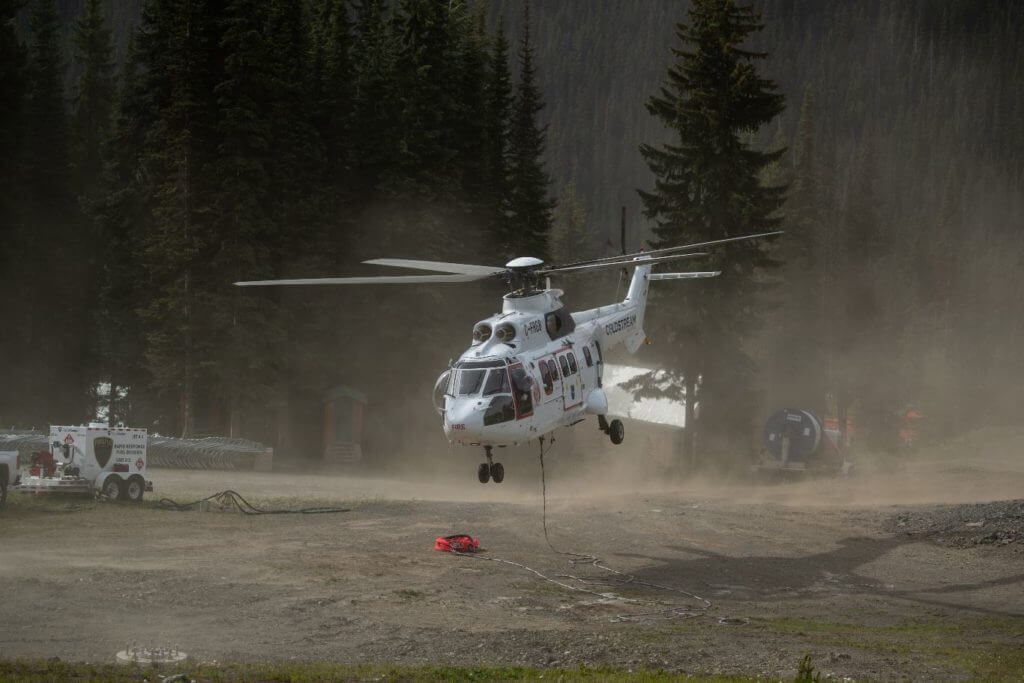Three Airbus AS332 L1 Super Pumas have arrived in Canada to begin a new life as utility/firefighting aircraft with operators Helicarrier Helicopters and Coldstream Helicopters.

The three were purchased by Quebec City, Quebec-based Helicarrier in late 2018 and early 2019. The operator then reached an agreement with Coldstream, based in Kelowna, British Columbia, to sell one of the aircraft to them.
As the Super Pumas had sat idle from their previous work as offshore transport aircraft for the last three years, they required some work to make them airworthy and transform them into utility aircraft.
“We had to uninstall a lot of the kits that were installed on the aircraft because they were Australian STCs [supplemental type certificates] that were not recognized here, as well as its offshore interior that needed to come out,” Fred Carrier, Helicarrier’s co-president, told Vertical. “The aircraft have been sitting since 2016, so there were a lot of ADs [airworthiness directives] and SBs [service bulletins] to complete to get them back up to date.”
The first aircraft received its Certificate of Airworthiness from Transport Canada in early June, and since then, it has already traveled to the Arctic and back and worked on powerline construction in Ontario.
HeliCarrier is a heavy-lift specialist, also operating three Sikorsky S-61Ns, as well as four Airbus AS350 AStars. All aircraft in the fleet are owned by the operator.
Carrier said the Super Pumas will be used for the same range of utility work as the company’s S-61s currently perform; a list of work that includes construction, firefighting, and general heavy lift operations.
The Super Puma has a similar lifting capability to the S-61, said Carrier — with the ability to carry around 9,600 pounds (4,350 kilograms) on the hook.
“The Super Puma has got a lot of power,” he said. “It performs really well in hot and high conditions, where older aircraft like the 61, which has got less power, they lose that performance really quickly above 8,000 feet.”
Carrier also praised the aircraft’s speed, and said he hoped the aircraft would prove as reliable as his AStars.
The training for Helicarrier’s staff has been completed in-house, with a couple of the company’s pilots already having extensive experience with the type.

Helicarrier is still working on the final AS332, and hopes to put it into operation in the fall. Carrier said he would consider expanding his company’s Super Puma fleet if there is a stable stream of business to support it.
Coldstream has also begun operations with its Super Puma, which it has converted into a Firecat. The operator had been looking to get into heavy-lift work for a little while, company president Rob Gallagher told Vertical. After looking into (and then deciding against) the Sikorsky S-70i Firehawk, he explored the idea of using a Super Puma after chatting to Heli Austria’s Roy Knaus.
“The AS332 L1 Super Puma is pretty much identical to the Firehawk in terms of capacity, weight, speed, and capability, and is type certified and readily available,” he said. “Plus, they still make lots of them and they’re civilian certified.”
The conversion of Coldstream’s Super Puma into a Firecat has followed a similar process to that completed by Heli Austria’s aircraft, gutting the instrument flight rules aircraft and turning it into a highly efficient utility/firefighting machine.
“The only thing we’ve done differently is take it one step further with the development of belly firefighting tanks and NVG [night vision goggle] capabilities for night fire operations,” said Gallagher.
Coldstream’s conversion reduces the aircraft’s empty weight by 3,500 pounds (1,590 kilograms), while adding several key pieces of equipment, including an Airbus hoist, specialized sponsons, dual bubble windows, the NVG compatibility, and a 4,200-liter belly tank.
Gallagher said Coldstream wouldn’t be operational with the NVG capability until next summer, while the tank is still in development with a partner, and is hoped to be ready for launch by the fall.
Until then, the aircraft will use a 4,000-liter (1,050-US gallon) Bambi Max 4000 bucket for firefighting operations. It has already worked on one fire — the Richter Mountain fire in British Columbia — during which it dropped 660,000 liters of water onto the fire on the first day of operations.
“It’s already an extremely effective tool for fire operations,” said Gallagher. “The amazing thing with this aircraft is its fuel range. We’re able to be over the top of a fire for three hours at a time, whereas most other aircraft, including heavies, are an hour to an hour and a half. So for a fire attack capability, the aircraft offers great overwatch.”
The aircraft has also completed its first hoist rescue (saving several climbers who had become stuck), recovered a crashed helicopter, has been used to dry cherries on a farm, and completed several construction jobs, including working on ski lifts. All this within its first few weeks in operation.

Gallagher said the feedback from customers has been good so far, and believes there is sufficient demand for the capabilities of the Super Puma/Firecat to sustain the use of the aircraft in the long term.
“The capital costs on the aircraft are reasonable, not astronomical — we’ve had quite positive feedback in terms of pricing,” he said. “I think there’s a market there and I think certainly from the utility and construction point of view, obviously they’re willing to pay that because of that capability of the aircraft. And I think fire agencies are very quickly catching on, and looking at new tools to actually deliver what they need onto these fires, which is people — we can move up to 20 firefighters at a time — and support them with 10,000 pounds of water in the initial attack phase.”
To bring the aircraft into the fleet, Coldstream hired two highly-experienced Super Puma pilots, and trained three of its existing pilots on the type. The company made a similar investment on the maintenance side.
So far, the Firecat has proved very maintenance-friendly, said Gallagher, and has proven a hit among the company’s pilots, too.
“You don’t really feel the fatigue after eight hours in the cockpit like you do with other aircraft,” he said. “It’s almost like being in a jetliner — it’s quiet, it’s smooth, and you don’t get the rattling and shaking like you do in other aircraft. It’s very enjoyable to fly.”










And they were sitting for years because nobody in oil and gas would fly them due to the transmissions failing and rotor systems falling off and flying away on their own? No mention of any of that?
The failures were all on the EC225 which is has a completely different transmission and rotor system from the 332L1. The L1 has been in service for many years with no problems.